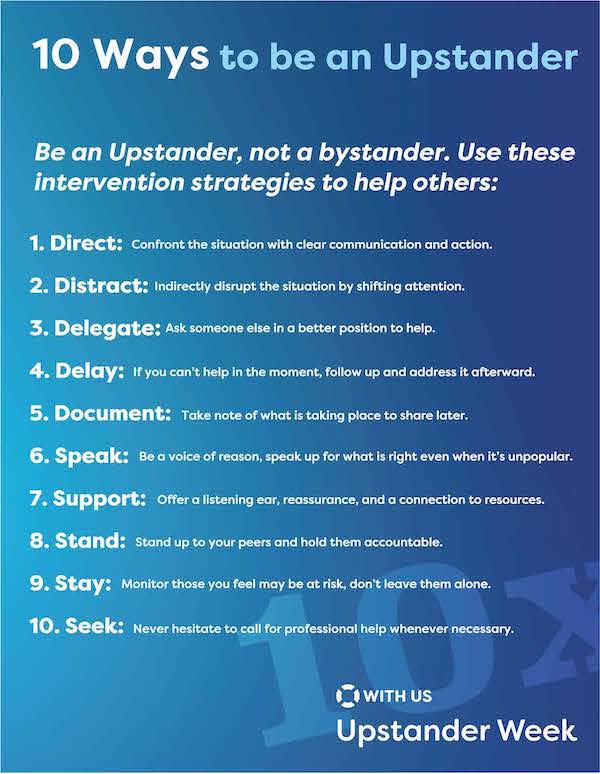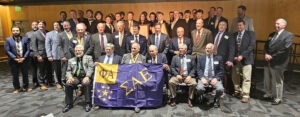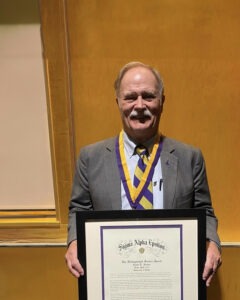There are moments in life that stay with us forever. One such moment for me was several years ago, the day I first heard the name Carson Starkey while I was watching “CBS Sunday Morning.” I was stunned and saddened as I heard about the senseless loss of Carson and the connection of this tragedy to the fraternity I love, Sigma Alpha Epsilon.
Little did I know then that my own journey would lead me to be the Fraternity’s current Eminent Supreme Recorder. As your ESR, I am pleased to report that much good has happened within our Fraternity. We are at a time of progress within SAE aimed at elevating our mission while doing what we can to see that Carson’s legacy is one of change within our Fraternity and the Greek world as a whole.
In the decade since Carson’s death, SAE has enacted Good Samaritan policies (see inset), eliminated pledging, banned hard alcohol, and dedicated ourselves to the evolution and expansion of the content, reach and frequency of our national education programming. We have ambitious goals, but these are endeavors worthy of our most serious efforts.
Sadly, Carson’s story is not the only one. Tim Piazza, Max Gruver and Marquise Braham all left this world far too early and in senseless circumstances. I am privileged to now know each of these young men’s parents and they have shared their personal stories with us and with attendees at the 2018 John O. Moseley Leadership School.
SAE is indebted to these families for their willingness to help us learn and grow.
 It is through Jim Piazza that I was able to first talk with Scott and Julia Starkey, a conversation I wanted, and needed, to have after 10 years of reflecting on what happened to Carson. They have been wonderful and have shared with me the many initiatives that have taken place to educate and prevent similar tragedies from taking place again.
It is through Jim Piazza that I was able to first talk with Scott and Julia Starkey, a conversation I wanted, and needed, to have after 10 years of reflecting on what happened to Carson. They have been wonderful and have shared with me the many initiatives that have taken place to educate and prevent similar tragedies from taking place again.
“Be an Upstander, not a Bystander” is one such initiative and it coincides perfectly with The True Gentleman. I ask you all to take a moment of your time and take the Upstander pledge. I also ask that you please read the article below which was written by Scott and Julia to honor Carson. Their perspective is one that we are honored to share. Use their message to make us all better brothers and better men.
Phi Alpha,
Mike Sophir
Eminent Supreme Recorder
Read the Op-Ed from the Starkey Family below.
In some ways, 10 years is a long time. In others, it’s gone in an instant.
We were married in the fall of 1984. A decade later, we were busy raising two boys: Hayden, age 6, and Carson, age 4. Ten years later, these two happy and healthy young men had left our nest equipped to conquer the world.
Then, on December 2, 2008, everything changed in an instant. Less than two decades after Carson came into our lives, he died following a fraternity hazing initiation ritual where he was compelled to drink large quantities of alcohol—unresponsive, unmonitored, and abandoned on a mattress. He was only 18 years old.
In 20 minutes, the son we’d raised from an infant to a fine young adult was gone, for reasons we’d grapple with, come to peace with, and that ultimately would drive our mission. It was a tragic and needless sacrifice — a wound that will never truly heal for our family. But, without question, it has also opened our minds and hearts in ways that would change everything we knew and, unexpectedly, in ways that would illuminate what Carson’s life was about.
We participated in our kids’ lives and kept them engaged and active, talking to them about being honest, the realities of life, their responsibility with their bodies, sex, alcohol, drugs, driving and generally being fully participating members of society. So, when Carson went off to Cal Poly in San Luis Obispo and Hayden was already a junior at the United States Naval Academy, we felt like they were securely on their way.
When Carson told us he was interested in pledging the Sigma Alpha Epsilon (SAE) fraternity — joining a fraternity was not something he had considered before — we knew he’d do it in his characteristically thoughtful way and we supported his decision. What we didn’t count on was that the hazing he was coerced to endure including the consumption of massive amounts of 190 proof Everclear and other hard alcohol would leave him lifeless. It was all made worse because he drank what his pledge brothers could not in order to ‘help them’ finish the task to leave all the bottles empty. The fraternity members he hoped to join looked on chanting “puke and rally.”
The part that makes his death so senseless – and as it turns out is a prevailing theme of alcohol poisoning stories across campuses every single year – was that his fraternity ‘brothers’ loaded him into a car to get help, but then turned back because they feared consequences. They ultimately decided to just let him sleep it off on that mattress.
Carson never woke up. But we did.
It was a Tuesday morning when we noticed a missed call on our caller ID from the San Luis Obispo County Coroner’s Office. In the hours, days, and months that would follow, investigations began, legal proceedings unfolded, and our world turned upside down. As we privately coped with losing our child, we were continually touched by how loved ones and strangers came out not only to comfort us, but to help make something good of Carson’s death.
In fact, when we came out to San Luis Obispo to bring Carson back home to Texas, we assumed we’d never return, but then we realized on that trip that his death had meaning after all. Between Cal Poly officials, friends and the San Luis Obispo community, we began to realize that there was a missing piece in preventing alcohol poisoning deaths that began to reveal itself to us.
Yes, he was brought to the brink of death because of a sadistic hazing ritual as part of a fraternity tradition. Yes, the availability of hard alcohol and a pop culture that said heavy drinking is a rite of passage and that the body can handle it all played a role. Yes, there were gaps between what we as parents impart and what schools and Greek organizations can enforce. But these are not the things that ultimately killed our son.
The reason Carson did not wake up on December 3, 2008 is because those young men — each of them goodhearted, from loving homes, and possessing competent educational backgrounds — did not have the fundamental knowledge or confidence to know how to do two exceedingly simple things: stay and call for help.
As time went on, we learned that there was an intended safety net for our young people as they transition from home to college life. They are given quizzes about serving sizes and blood alcohol content. They are lectured on responsibility and they “crack down” in an effort to make the liquor harder to get and off limits for those in campus housing or fraternity and sorority houses. While these efforts are important, young people are creative and they naturally want to test the limits. It is a tragic tale we read about time and again, most recently with the loss of Tim Piazza, Max Gruver, Andrew Coffee, and Matthew Ellis – among many others who senselessly lost their lives just as Carson did.
We share their families’ pain — and resolve.
What we and the thousands of students, staff, administrators, colleague nonprofits, victim families, board members, volunteers and partners have learned over time is that while it takes education early and often, it takes structure and enforcement, and it takes amnesty and hazing laws, as well as policies that remove the fear to call for help. The critical ingredient is cultivating our inherent core value to help one another.
Help one another!
This is what Carson was all about in his 18 years. This is what so many of you have showed us in your deeds and words. This is what the students tell us again and again and again. Helping one another — peer to peer — without scare tactics or preaching sobriety to young people. It’s the sensible pathway for saving the most lives. This is not our discovery of course; this is just what the collective wisdom of our community made evident.
In some ways, 10 years is a long time. In others, it’s over in an instant. It’s hard to express what’s transpired in the past decade since we lost Carson. We hesitate to say that it happened for a reason, but maybe the inverse is true: that his death created reason – reason to examine the circumstances and similarities, reason to connect with others, and reason to be a part of connecting the dots.
As we think about what these 10 years mean to us, the overwhelming sentiment is one of gratitude. Our grief for Carson is ongoing, but what has become bigger than that is the optimism and commitment of hundreds and hundreds of people that continue to step up to help. It’s the letters we’ve received from young people and their parents, telling us that Carson’s Story and the tools provided by Aware Awake Alive reminded them to stay and call for help. That is redeeming and something that honors Carson’s life. We will never know how many lives may have been changed or saved, but we know that it’s enough. Any one life is worth everything.
Our loss and time have granted us a deep sensitivity to the joy of helping others. There is no greater feeling than knowing in your soul that you are helping other people, putting them before yourself. Whatever “your cause” or tradition may be, we challenge you to devote yourself to those who the cause serves. Take yourself out of the equation. The result will be you finding more happiness and satisfaction than you ever could by doing something self-serving. Always give more than you receive.
These intentions and Carson’s legacy initially became the nonprofit With Carson, then Aware Awake Alive. Last year our family gifted the Aware Awake Alive nonprofit to Cal Poly and it became the catalyst for WITH US: The National Network for Peer Accountability at California Polytechnic University. With the California State University platform, and a devoted staff, we’re laying the foundation for fundamental change at a national level.
WITH US is growing a national network of partners commited to creating safer campus communities. This year they’ve launched the first phase of their National College Student Bystander Study and are designing evidence-based bystander intervention programs. This week, a series of conversations inspired by Carson’s story took place on campuses across the country challenging peers to be an “upstander” – an individual who sees wrong and acts. Now our collective challenge is to remind our young people that they belong to each other and that they can leave no one behind. It is up to every one of you to pass this message along
And because the road goes on, we have one more message for you
It has been said that “those we hold closest to our hearts never truly leave us. They live on in the kindness they have shared and the love they brought into our lives.” Carson lives on through the work of WITH US and, more importantly, in your knowledge and your actions. He lived life with urgency and we suggest you do as well. You never know what tomorrow may bring. So, “bring it” today!
As we continue on the mission helping others and being grateful for the road behind us, we’re at peace, thanks in large part to these 10 gifts this experience has brought us. We honor them as we honor you for remembering Carson and all of those that have been lost before him and since.
- Help one another. You know what is right — just act on your goodness.
- No excuses. Don’t let the rules of your organization, school, tribe or brotherhood overshadow that we all belong to each other. No tradition is worth dying for.
- Be open to possibility. Losing Carson and giving ourselves and to a certain extent our total privacy to the solution has made us set aside “our way” in favor of the collective good.
- Grief has no rules. We felt the freedom to grieve in our own way and on our own timeframe. This has included allowing ourselves to be happy. And saving a place in the darkness for Carson is okay
- Forgiveness. Forgive yourself. Forgive the young people that did not know. Forgive the rule makers and the rule breakers.
- Positivity inspires possibility. Certainly heartache and sorrow persist – but what gets people involved and empowered is a sense that they can make a difference.
- Answer the phone.Friends and strangers came out of the woodwork to share their condolences but also to offer help. It was overwhelming at times, but when we could give them something to do or think about, it was rewarding and fruitful. We honor them especially and will never forget their generous hearts.
- Don’t tolerate the B.S.It’s appropriate to be gracious when you lose a child, especially when you’re on a mission to change the status quo. We are so very grateful for all the support we’ve received, but politeness has no place when confronted with systems and attributes that continue to leave young people dead year after year. Don’t be afraid to speak the truth. Call it like you see it.
- The answer is bigger than your problem. Help one another by working with one another. There’s a lot of responsibility and protectiveness you feel to your child’s legacy. And that is worth honoring. But to the extent their memory only goes so far and for so long… allow other people in and don’t let the past or your particular circumstances weigh you down.
- Stay. Whether it is a friend in need, grief you want to escape, a sense of obligation that makes you uncomfortable, a hard hill to climb, or a darkness that haunts you as you seek the light … stay. Trust that the answer is there and that capable people are near to help. The difference between anguish and resolve, between solitude and gratitude, between life and death may well be you. So stay.
And because the lessons never end, here’s one more for the future:
- Collaborate. The solution is unequivocally with the greater US. No one person, family, or entity is at the root of the problem and therefore it will require all of us to band together to change the culture and save these lives.
Gratefully,
Julia and Scott with Carson
WITH US





